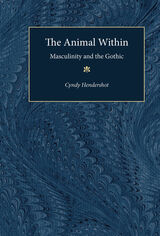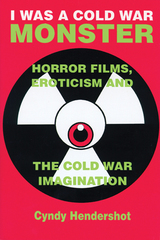3 books about Hendershot, Cyndy

The Animal Within
Masculinity and the Gothic
Cyndy Hendershot
University of Michigan Press, 1998
As Cyndy Hendershot demonstrates, the Gothic is more a mode than a rigid historical period, an "invasive" tendency that reveals the imaginative limits of social realities and literary techniques far beyond its origins in late eighteenth century Britain. And as she demonstrates in this first scholarly treatment of its kind, one of the continuing obsessions of the Gothic mode is masculinity. Masculinity is in some sense a Gothic castle of the imagination, haunted by fears of the body, science, and angry colonial subjects.
The book's keen critical insight, meticulous close readings and cross-cultural comparisons interrogate the historically situated function of masculinity in texts and films that range across the two-hundred year history of the Gothic. Matthew Lewis's The Monk is compared to Philip Kaufman's Invasion of the Body Snatchers to reveal the "hauntedness" of the male body. Hawthorne's short story "The Birthmark" is juxtaposed with J. S. Le Fanu's "Green Tea" to ground the fantastic qualities of the scientific imagination. Conrad's Heart of Darkness converses with Jean Rhys's Wide Sargasso Sea about the nature of imperialism. And Jane Campion's film The Piano is figured as an imaginative foray into new forms of masculinity. Utilizing the insights of Lacanian theory, Hendershot demonstrates how the Gothic realm of ghosts, demons, and hidden passages continues to suggest alternative realities to claustrophobic cultural imaginations.
"Masculinity and the Gothic combines solid literary critical insight and close readings in a detailed and lively survey of various manifestations of the gothic within British and American cultural traditions, and admirably explores the connections between various cultural discourses. It will make a fine complement to the numerous recent publications of issues of femininity in the gothic." --Sharon Willis, University of Rochester
Cyndy Hendershot is Assistant Professor of English, Arkansas State University.
The book's keen critical insight, meticulous close readings and cross-cultural comparisons interrogate the historically situated function of masculinity in texts and films that range across the two-hundred year history of the Gothic. Matthew Lewis's The Monk is compared to Philip Kaufman's Invasion of the Body Snatchers to reveal the "hauntedness" of the male body. Hawthorne's short story "The Birthmark" is juxtaposed with J. S. Le Fanu's "Green Tea" to ground the fantastic qualities of the scientific imagination. Conrad's Heart of Darkness converses with Jean Rhys's Wide Sargasso Sea about the nature of imperialism. And Jane Campion's film The Piano is figured as an imaginative foray into new forms of masculinity. Utilizing the insights of Lacanian theory, Hendershot demonstrates how the Gothic realm of ghosts, demons, and hidden passages continues to suggest alternative realities to claustrophobic cultural imaginations.
"Masculinity and the Gothic combines solid literary critical insight and close readings in a detailed and lively survey of various manifestations of the gothic within British and American cultural traditions, and admirably explores the connections between various cultural discourses. It will make a fine complement to the numerous recent publications of issues of femininity in the gothic." --Sharon Willis, University of Rochester
Cyndy Hendershot is Assistant Professor of English, Arkansas State University.
[more]

I Was a Cold War Monster
Horror Films, Eroticism, and the Cold War Imagination
Cyndy Hendershot
University of Wisconsin Press, 2001
Horror films provide a guide to many of the sociological fears of the Cold War era. In an age when warning audiences of impending death was the order of the day for popular nonfiction, horror films provided an area where this fear could be lived out to its ghastly conclusion. Because enemies and potential situations of fear lurked everywhere, within the home, the government, the family, and the very self, horror films could speak to the invasive fears of the cold war era. I Was a Cold War Monster examines cold war anxieties as they were reflected in British and American films from the fifties through the early sixties. This study examines how cold war horror films combined anxiety over social change with the erotic in such films as Psycho, The Tingler, The Horror of Dracula, and House of Wax.
[more]

Paranoia, the Bomb, and 1950s Science Fiction Films
Cyndy Hendershot
University of Wisconsin Press, 1999
Cyndy Hendershot argues that 1950s science fiction films open a window on the cultural paranoia that characterized 1950s America, a phenomenon largely triggered by use of nuclear weapons during World War II. This study uses psychoanalytic theory to examine the various monsters that inhabit 1950s sci-fi movies—giant insects, prehistoric creatures, mutants, uncanny doubles, to name a few—which serve as metaphorical embodiments of a varied and complex cultural paranoia. Postwar paranoia may have stemmed from the bomb, but it came to correlate with a wider range of issues such as anti-communism, internal totalitarianism, scientific progress, domestic problems, gender roles, and sexuality.
[more]
READERS
Browse our collection.
PUBLISHERS
See BiblioVault's publisher services.
STUDENT SERVICES
Files for college accessibility offices.
UChicago Accessibility Resources
home | accessibility | search | about | contact us
BiblioVault ® 2001 - 2024
The University of Chicago Press









